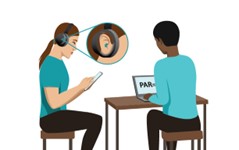Enhancing Workplace Safety: A Systematic Review of Hearing Protection Fit-Testing Systems and Training
Posted on by
Exposure to excessive noise at work poses significant health risks for workers. These include hearing loss, tinnitus, and various other health conditions. To mitigate these risks, hearing protection devices (HPDs) such as earplugs and earmuffs are commonly used. However, the effectiveness of HPDs relies heavily on proper usage and fit. Ill-fitting earplugs are a common challenge faced by workers, compromising their ability to adequately protect their hearing.
Hearing protection fit-test systems are technologies designed to measure the level of noise reduction achieved when wearing HPDs. These systems provide valuable insights into the effectiveness of different devices in attenuating or reducing noise at the ear. A few countries have published standards recommending or regulating the use of fit testing as part of hearing conservation interventions (Wells et al., 2024). The countries include:
- Recommending: Argentina, Australia, Brazil, Italy, Malaysia, Russia, Uruguay, Venezuela
- Regulating: Canada, Germany, USA*
*The Department of Defense Instruction (DODI) 6055.12: Hearing conservation and readiness program (Dept. of Defense, 2023)
Systematic reviews of the effectiveness of various interventions are critical in providing integrated information for decision-makers. A recently published systematic review evaluated the efficacy of hearing protection fit-testing systems and associated training in reducing workers’ noise exposure. (Morata et al., 2024). Its aim was also to contribute to the framing of future research and towards the implementation of new standards.
Three different studies (involving a total 756 participants) were included in the systematic review. These studies evaluated the impact of providing simple or extensive training for inserting and fitting foam or pre-molded earplugs. Extensive training includes personalized instruction, while simple training lacks one-on-instruction.
The results indicated that simple instructions accompanying fit testing did not significantly improve personal attenuation ratings compared to no instructions. However, fit testing with extensive instructions showed promise in enhancing workers’ protection against noise immediately after the test and training sessions. The effectiveness of fit testing may vary depending on the type of HPD and training methods employed.
The studies in this review had some limitations. To increase the certainty of the evidence, the authors suggest that more randomized controlled trials of fit testing HPDs with instructions on how to improve their fit are needed, as well as studies of implementation schedules and processes.
While further research may strengthen our understanding of hearing protection fit-testing systems and associated training methods, this systematic review highlights their potential in improving workplace safety by reducing workers’ exposure to harmful levels of noise.
Have you incorporated fit testing hearing protection at your work? Give us your thoughts below!
Thais C. Morata, PhD, is a Co-Manager of the NIOSH Hearing Loss Prevention Program and a Research Audiologist in the NIOSH Division of Field Studies and Engineering.
Wei Gong, MS, is a Research Industrial Hygienist in the NIOSH Division of Field Studies and Engineering.
Asha Brogan, MS, is a Health Communication Fellow in the NIOSH Division of Field Studies & Engineering.
References
Morata TC, Gong W, Tikka C, Samelli AG, Verbeek JH. Hearing protection field attenuation estimation systems and associated training for reducing workers’ exposure to noise. Cochrane Database of Systematic Reviews 2024, Issue 5. Art. No.: CD015066. https://doi.org/10.1002/14651858.CD015066.pub2).
Wells LL, Schulz TY, Saleem M, Dantscher S, Borst B, Giguere C, Fackler C, Murphy W. Standards and Regulations for Hearing Protector Fit Testing – Outcomes of the International Hearing Protector Fit-Testing Symposium. Proceeding of Meetings on Acoustics 2024;53:1-12. https://doi.org/10.1121/2.0001843
Posted on by

